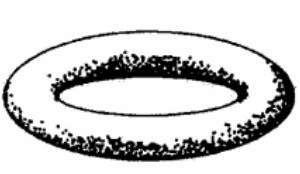Introduction:
A simplicial complex is a special type of graph wherein the notion of a vertex is replaced with a higher dimensional analog, called a simplex. A simplex is, in simplest terms, an n-dimensional collection of vertices enclosed by faces. Simplicial complexes arise as a natural extension of basic graph theory.
Definitions:
Graph:
"A graph G = (V, E) consists of V, a nonempty set of vertices (or nodes) and E, a set of edges. Each edge has either one or two vertices associated with it, called its endpoints. An edge is said to connect its endpoints."1
Simplex:
"A simplex...is the generalization of a tetrahedral region of space to n dimensions."2
A simplex of n dimensions is referred to as an n-simplex.
| Dimension | Name |
| 0 | 0-Simplex or Point |
| 1 | 1-Simplex or Line Segment |
| 2 | 2-Simplex or Triangle |
| 3 | 3-Simplex or Tetrahedron |
| n | n-Simplex |
Simplicial Complex:
"...a simplicial complex K in Rnis a collection of simplices in Rn such that...every face of K is in K, and...the intersection of any two faces of K is a face of each of them."3
Simplicial Complexes:
In an connected planar graph, Euler's Formula E + 2 = V + F for which V is the number of vertices, F is the number of faces, and E is the number of edges holds.Whereas ordinary graphs are composed of 0-dimensional points (called vertices), a simplicial complex removes this restriction. Where a regular graph would have a vertex, a simplicial complex can contain any simplex (including a 0-dimensional point through an n-simplex).
Geometric Meaning of Euler’s Formula:
According to Euler Characteristic, any convex polyhedron's surface has Euler characteristic E + 2 = V + F.
Note that Polyhedral is composed of multiple faces.
Remove one face of the polyhedral surface and pull the edges of the missing face away from each other, deform all the rest into a planar graph of points and curves(Assuming that polyhedral surface is homeomorphic to the sphere). After this deformation, the regular faces are generally not regular anymore. The number of vertices and edges has remained the same, but the number of faces has been reduced by 1. Therefore, proving Euler's formula for the polyhedron reduces to proving V − E + F =1 for this deformed, planar object.
Apply repeatedly either of the following two transformations, maintaining the invariant that the exterior boundary is always a simple cycle:
1. Remove a triangle with only one edge adjacent to the exterior, as illustrated by the second graph. This decreases the number of edges and faces by one each and does not change the number of vertices, so it preserves V − E + F.
2. Remove a triangle with two edges shared by the exterior of the network, as illustrated by the third graph. Each triangle removal removes a vertex, two edges and one face, so it preserves V − E + F.
Remove a triangle with two edges shared by the exterior of the network, as illustrated by the third graph. Each triangle removal removes a vertex, two edges and one face, so it preserves V − E + F. These transformations eventually reduce the planar graph to a single triangle. (Without the simple-cycle invariant, removing a triangle might disconnect the remaining triangles, invalidating the rest of the argument. A valid removal order is an elementary example of a shelling.)
At this point the lone triangle has V = 3, E = 3, and F = 1, so that V − E + F = 1. Since each of the two above transformation steps preserved this quantity, we have shown V − E + F = 1 for the deformed, planar object thus demonstrating V − E + F = 2 for the polyhedron. This proves the theorem.4
Simplicial Complex Analog of Euler's Formula:
If the surface of a polyhedron have h(h>=0, the number of tori in a connected sum decomposition of the surface/number of handles) then the Euler characteristic is 2 - 2*h ==> E + 2 - 2*h = V + F

We know that the number of handle of "triangulated" doughnut is h = 1. According to the equation above ==> E + 2- 2*1 = V + F ==> E = V + F

The number of handles of "triangulated" sphere is h = 0. According to the equation above ==> E + 2- 2*0 = V + F ==> E + 2 = V + F
1 Found in Discrete Mathematics and Its Applications, Kenneth H. Rosen.
2 Found at http://mathworld.wolfram.com/Simplex.html.
3 Found at http://mathworld.wolfram.com/SimplicialComplex.html, adapted from J. R. Munkres, "Simplicial Complexes and Simplicial Maps," 1993.
4 Euler's Characteristic http://en.wikipedia.org/wiki/Euler_characteristic


